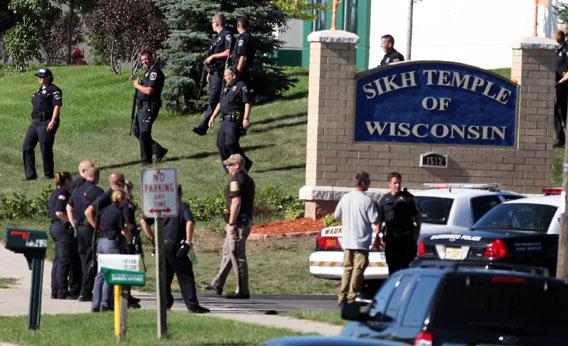Six people were shot and killed by a white supremacist gunman at a Sikh temple (or gurdwara) in Oak Creek, Wis., yesterday. How do Sikhs honor their dead?
With a funeral ceremony called antam sanskar. Antam means “final” in Punjabi, the language of Sikh religious texts, while sanskar is a term referring to any rite or ritual. Before the ceremony, the body is washed with water and adorned with the five articles of faith that initiated Sikhs are supposed to carry or wear at all times in life: kesh (uncut hair, which is covered by a turban), kanga (a wooden comb), kachhera (an undergarment resembling a pair of shorts), kara (an iron bracelet), and kirpan (a short sword).
The ceremony usually occurs two to three days after a death and is performed by loved ones with the help of a granthi, the Sikh equivalent of a priest. It usually begins at a funeral parlor immediately before cremation. Mourners sing hymns from the Guru Granth Sahib, the Sikh holy text, and recite a bedtime prayer called the Kirtan Sohila and a supplication to God called the Ardas. (Sikhs often refer to God as Waheguru, which means “wonderful teacher,” and recitations of “Waheguru” are common on people’s deathbed and during antam sanskar.) As with Western funerals, the ceremony may also include words of remembrance from friends and family members.
The body is then cremated and the ashes are scattered in a body of water, although if cremation is impractical, the body can be buried or disposed of in another way. (In modern-day America, cremation is so widely accessible that virtually all American Sikhs are cremated.) After the body is cremated, the mourners go to their temple for a full service including readings from the Guru Granth Sahib, more hymns, and more prayers. The family of the deceased may also follow the funeral ceremony by reading the entire Guru Granth Sahib aloud, which takes about 48 hours.
Sikhs believe that humans have immortal souls that are reincarnated in different forms depending on one’s earthly actions and on God’s will. As a result, Sikhs are encouraged to see death as a chance for someone to continue his or her journey closer to God. Sikhs don’t bury bodies or ashes in marked graves, because the body is seen as a vessel that becomes empty once the soul has departed.
Sikhism is a monotheistic religion founded by Guru Nanak in the 15th century in Punjab, which today spans parts of Pakistan and northern India. Punjabi India has the world’s highest concentration of Sikhs. There are 25 million Sikhs worldwide, including about 700,000 in the United States, as estimated by the Sikh American Legal Defense and Education Fund. Sikhism was founded as an egalitarian religion, and Sikh funerals, like all Sikh rites, are notable for making no distinction between how men and women are treated.
Got a question about today’s news? Ask the Explainer.
Explainer thanks Navdeep Singh of the Sikh American Legal Defense and Education Fund.
